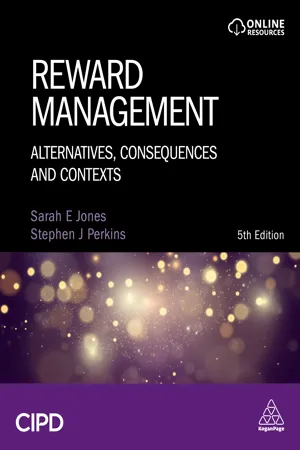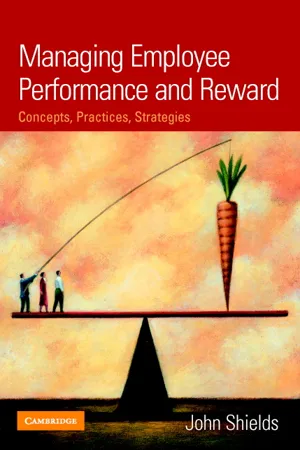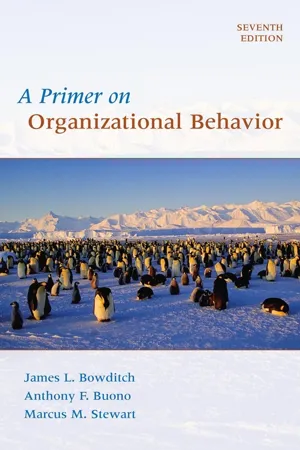Business
Reinforcement Theory
Reinforcement theory in business refers to the use of positive or negative consequences to strengthen or weaken behaviors within an organization. It is based on the idea that behavior that is rewarded or positively reinforced is more likely to be repeated, while behavior that is punished or negatively reinforced is less likely to occur in the future. This theory is often used in management and leadership to shape employee behavior and performance.
Written by Perlego with AI-assistance
Related key terms
1 of 5
10 Key excerpts on "Reinforcement Theory"
- eBook - PDF
- John R. Schermerhorn, Jr., Paul Davidson, Peter Woods, Aharon Factor, Fatima Junaid, Ellen McBarron(Authors)
- 2019(Publication Date)
- Wiley(Publisher)
Reinforcement Theory, in contrast, views human behaviour as determined by its environmental consequences. Instead of looking within the individual to Pdf_Folio:386 386 Management explain motivation and behaviour, it focuses on the external environment and the consequences it holds for the individual. The basic premises of the theory are based on what E. L. Thorndike called the law of effect — behaviour that results in a pleasant outcome is likely to be repeated; behaviour that results in an unpleasant outcome is not likely to be repeated. 46 Reinforcement strategies Psychologist B. F. Skinner popularised the concept of operant conditioning as the process of applying the law of effect to control behaviour by manipulating its consequences. 47 You may think of operant conditioning as learning by reinforcement. In management the term is often discussed with respect to organisational behaviour modification (OB Mod), the application of operant conditioning techniques to influence human behaviour in the workplace. 48 The goal of OB Mod is to use reinforcement principles to systematically reinforce desirable work behaviour and discourage undesirable work behaviour (see figure 15.7). FIGURE 15.7 Applying reinforcement strategies: case of total quality management Supervisor’s objective Individual behaviour Reinforcement strategy Type of reinforcement Meets production goals with zero defects Meets production goals but with high percentage of defects Praise employee; recommend pay increase Stop complaints Positive reinforcement Extinction Negative reinforcement Punishment High-quality production Reprimand employee Withhold praise and rewards Four strategies of reinforcement are used in operant conditioning. Positive reinforcement strengthens or increases the frequency of desirable behaviour by making a pleasant consequence contingent on its occurrence. For example, a manager nods to express approval to someone who makes a useful comment during a staff meeting. - eBook - ePub
Reward Management
Alternatives, Consequences and Contexts
- Sarah Jones, Stephen J Perkins(Authors)
- 2024(Publication Date)
- CIPD - Kogan Page(Publisher)
Reinforcement Theory (Skinner, 1953) extends notions of learned behaviour and locates it in social encounters. Under this conceptualisation, the managerial role becomes central in motivational encounters (‘social learning’). The assumption of this theory is that people seek positive reinforcement for their actions. Reinforcement Theory may in fact be viewed as less a motivational theory and more concerned with subjects’ responses to social encounters. Managers ‘educate’ employees in what is required to secure the desired reinforcement for their actions, and the task of management is to find out what will act to reinforce desired behaviour among subordinates and then monitor and appraise accordingly. Under this theory, differentiating between employees’ individual performance outcomes will reinforce the learned connection between action and reward. Under Reinforcement Theory, people’s mental state is ignored (Steers and Porter, 1987). The emphasis is on learning about how particular ways of ‘operating on the environment’ (another way of describing behaviour) lead to rewarding outcomes, reinforcing the aim for favourable rewards to be achieved and to avoid situations that carry penalties.An alternative, ‘cognitive’ approach to motivation theory – where it is assumed that employees are thinking individuals who make rational choices based on experience – offers a corrective to instinct and drive-based theory. Here, rather than ‘hedonism of the past’, grounded in habit, a form of ‘hedonism of the future’ is postulated. Employee behaviour may be perceived as purposeful and goal-directed, grounded in beliefs and expectations surrounding future events. Goal-setting theory (Locke et al, 1981) and expectancy theory - eBook - PDF
Organizational Behavior
Managing People and Organizations
- Ricky Griffin, Jean Phillips, Stanley Gully, , Ricky Griffin, Jean Phillips, Stanley Gully(Authors)
- 2019(Publication Date)
- Cengage Learning EMEA(Publisher)
The group may indicate how the organization expects its members to dress, how people are “supposed” to feel about the boss, and so forth. Hence, the employee learns how to behave in the new situation partly in response to what she already knows and partly in response to what others suggest and demonstrate. Behavior Modification Learning theory alone has important implications for managers, but organiza-tional behavior modification has even more practical applications. Behavior modification is the application of Reinforcement Theory to influence the behav-iors of people in organizational settings. 59 One aspect of behavior modification is the use of various kinds of reinforcement when employees are observed behaving in desired or undesired ways. Figure 5.7 summarizes these kinds of reinforce-ment. We will now discuss these different kinds of reinforcement in more detail, and then look at different times to apply them. 60 Kinds of Reinforcement There are four types of reinforcers, as shown in Figure 5.7. Positive reinforcement involves the use of rewards to increase the likelihood that a desired behavior—high performance, for instance—will be repeated. For example, when a manufacturing employee wears uncomfortable but important safety gear, the manager can give the employee praise to increase the likelihood that the employee will wear the safety equipment in the future. Positive reinforcement has been used at a Sears behavior modification The application of Reinforcement Theory to influence the behaviors of people in organizational settings Types of Reinforcers 60 Figure 5.7 Individual behavior can be affected when stimulus is either presented or removed after a particular behavior. This is also dependent on whether the stimulus is positive or negative. Sources: Based on B. Lachman, F. Camm, & S. A. Resetar, Integrated Facility Environmental Management Approaches: Lessons from Industry for Department of Defense Facilities , 2001. - eBook - PDF
Managing Employee Performance and Reward
Concepts, Practices, Strategies
- John Shields(Author)
- 2007(Publication Date)
- Cambridge University Press(Publisher)
The implications for effective reward management are quite clear: the behaviour and results expected from each employee should be clearly spelt out, and each time these are demonstrated an extrinsic reward of sig- nificant value to the recipient should follow immediately afterwards. The more instantaneous the reward and the reinforcement – that is, the sharper the cognitive ‘line of sight’ between the two – the better for all concerned. The problem with Reinforcement Theory is that it takes a depressingly mechanistic view of the human condition. If the behaviour of rats can be programmed by means of extrinsic rewards and punishments, so too can that of people. The contrast with content theories could not be greater. Indeed, Herzberg (1987) refers derisorily to Skinnerian behaviourism as the ‘KITA’ (‘Kick-In-The-Ass’) view of employee motivation. Others (e.g. Kohn 1993a) argue that sole reliance on extrinsic rewards and punishments might well serve to extinguish intrinsic motivation by taking away the self-control that employees might otherwise be able to exercise in their jobs. It may well make employees feel manipulated, humiliated and powerless, and give rise to resentment and dissatisfaction. In short, Reinforcement Theory is probably applicable only to roles and task behaviour that are simple and routine. Expectancy theory Expectancy theory draws on Reinforcement Theory but takes a more subtle and contingent approach to motivation. Pioneered by Victor Vroom (1964), and extended by Porter and Lawler (1967) and Lawler (1971), expectancy theory has for decades been regarded by many as offering the most practical insights on motivation management. Indeed, Lawler has been a leading con- tributor to the practitioner-focused literature on performance and reward matters since the 1970s. Expectancy theory is based on the assumption that work behaviour is determined by individual expectations of the likely consequences of such behaviour. - eBook - PDF
- James L. Bowditch, Anthony F. Buono, Marcus M. Stewart(Authors)
- 2015(Publication Date)
- Wiley(Publisher)
In contrast to the preceding theories, the perspectives discussed in this section view motivation as an intervening and dependent variable. Thus, the focus is on the antecedents of those variables to which we commonly attribute motivated behavior. Operant Conditioning and Reinforcement Theory The basic assumption underlying B.F. Skinner’s theory of operant conditioning is that human behavior is determined and maintained by the person’s environment. Although behavior may be random at first, as an individual explores the environment and reacts to it, certain behaviors will be reinforced and subsequently repeated. Thus, according to Skinnerian theory, an individual’s behavior or motivation is a function of the consequences of that behavior. 80 If we are rewarded for behaving in a certain way, we begin to make the connection between the appropriate behavior and the reward, and continue to engage in that behavior. Thus, from a managerial perspective, Reinforcement Theory suggests that if you desire to maintain a certain behavior in the workplace, you must be able to manipulate the consequences of that behavior. 81 By providing employees with a valued reward for punctuality, for example, a manager should be able to control tardiness. Since this perspective assumes that all behaviors have an operant conditioning basis, motivation is reduced to identifying needs and providing appropriate rewards. The discussion thus far has focused on positive reinforcement (rewards) to encour- age the repetition of certain behaviors. Although most reinforcement theorists argue that positive reinforcement is the most effective way of sustaining desired behaviors, negative reinforcement (avoidance; the withdrawal of negative consequences) can also increase the likelihood that desired behaviors will be repeated. Punishment, in con- trast, is not intended to encourage desired (positive) behavior but rather to discourage those behaviors we do not want repeated. - eBook - PDF
Managing Employee Performance and Reward
Concepts, Practices, Strategies
- John Shields, Michelle Brown, Sarah Kaine, Catherine Dolle-Samuel, Andrea North-Samardzic, Peter McLean, Robyn Johns, Patrick O'Leary, Geoff Plimmer, Jack Robinson(Authors)
- 2015(Publication Date)
- Cambridge University Press(Publisher)
Reinforcement Theory makes four essential points about the association between motivation, effort and rewards: 1 Rewards do reinforce performance. 2 To reinforce desired behaviour, rewards must follow immediately after the behaviour. 3 Behaviour that is not rewarded will be discontinued (‘extinguished’). 4 Withholding rewards (or reward increases) is a powerful means of discouraging unwanted behaviour or misbehaviour. Reinforcement Theory provides the implicit or explicit rationale for all forms of per- formance-contingent extrinsic reward. In particular, it suggests that performance in- centives have a positive and powerful role to play in reinforcing desired behaviour in PART 1: THE FUNDAMENTALS 28 situations where financial incentives are highly valued. The implications for effective reward management are quite clear: the behaviour and results expected from each employee should be clearly spelt out, and each time these are demonstrated an extrin- sic reward of significant value to the recipient should follow immediately afterwards. The more instantaneous the reward and the reinforcement – that is, the sharper the cognitive ‘line of sight’ between the two – the better for all concerned. The problem with Reinforcement Theory is that it takes a depressingly mechanistic view of the human condition. If the behaviour of rats can be programmed by means of extrinsic rewards and punishments, so too can that of people! The contrast with content theories could not be greater. Indeed, Herzberg (1987) refers derisorily to Skinnerian behaviourism as the ‘KITA’ (‘Kick-In-The-Ass’) view of employee moti- vation. Others (e.g. Kohn 1993a) argue that sole reliance on extrinsic rewards and punishments might well serve to extinguish intrinsic motivation by taking away the self-control that employees might otherwise be able to exercise in their jobs. It may well make employees feel manipulated, humiliated and powerless, and give rise to resentment and dissatisfaction. - eBook - ePub
- Merilynn Van Der Wagen(Author)
- 2007(Publication Date)
- Routledge(Publisher)
4Reinforcement TheoryLearning is an enduring change in the mechanisms of behaviour involving specific stimuli and/or responses that result from prior experience with those or similar stimuli and responses…The only way to prove that the training experience is causing the behaviour change of interest is to experimentally vary the presence and absence of that experience. For this reason, learning can be investigated only with experimentation techniques.Domjan, 2003, p. 15Central themeBehaviour modification principles can be used to shape effective customer service behaviours. Reinforcement can occur in the form of extrinsic rewards provided by customers, supervisors or peers. Alternatively, reinforcement can occur in the form of self-reinforcement (intrinsic reward). Intermittent reinforcement creates the most sustainable behaviour. Performance standards (verbal coding of exemplary customer service behaviours) can contribute to the individual’s capacity for self-reinforcement.Training implications1 Describe learning outcomes in behavioural terms. 2 Use tangible and intangible rewards for reinforcement. 3 Use observational learning to build performance to the required standard. 4 While shaping behaviour ensure that each level of performance is achievable. 5 Explain and demonstrate what exemplary customer service looks like so that learners can become self-reinforcing when they achieve the performance standard. 6 Consolidate behaviour and transfer across a range of scenarios.IntroductionTraining plans usually have behavioural outcomes or objectives as the focal point. This is not to say that affective and cognitive outcomes are not achieved too, as these three domains seldom work in isolation. However, most trainers have been taught to respond to the question, ‘what will the trainee be able to do on completion of the training?’ These learning objectives usually commence with an action beginning. For example, on completion of training, the trainee will be able to: - eBook - PDF
Learning Psychology NQF4 SB
TVET FIRST
- N Horn P Huygen(Author)
- 2013(Publication Date)
- Macmillan(Publisher)
18 2 .3 .2 B . F . Skinner Skinner (1904–1990) formulated a more detailed theory of operant conditioning. His theory is based on reinforcement, punishment and extinction. His theory deals with changes in behaviour that can be observed and he ignores the possibility of any processes that may occur in the mind of the individual. According to Skinner, reinforcement and punishment are either positive, or negative. Positive reinforcement is given directly after a response; negative reinforcement is when reinforcement is withdrawn after a response. In the context of this theory, the terms ‘ positive ’ and ‘ negative ’ do not have their usual meaning, rather ‘ positive ’ refers to addition (adding) and ‘ negative ’ refers to subtraction (taking away). You can add or subtract either reinforcement or punishment. In other words, you can add reinforcement or punishment to the behaviour of an individual, or you can take away reinforcement or punishment from the behaviour. In the context of this theory, therefore, punishment is sometimes a confusing term, because it indicates the addition of punishment, such as spanking, a context that may seem very negative to most people. Reinforcement Reinforcement is a consequence that causes behaviour to occur more frequently. There are two reinforcement procedures: Positive reinforcement • takes place when a desired behaviour or response is followed by a favourable stimulus that increases the frequency of that behaviour occurring. An example is saying ‘ well done ’ to a learner or rewarding a class with time off as a result of good work. Negative reinforcement • takes place when a desired behaviour (response) is followed by taking away an unpleasant stimulus, thereby increasing the possibility that the desired behaviour will be displayed again. For example, as a result of good marks, a child is excused from washing dishes for a week. - eBook - PDF
Behavior Modification
Principles and Procedures
- Raymond Miltenberger, , , (Authors)
- 2015(Publication Date)
- Cengage Learning EMEA(Publisher)
4 Reinforcement ■ What is the principle of reinforcement? ■ How is positive reinforcement different from negative reinforcement? ■ How are unconditioned reinforcers different from conditioned reinforcers? ■ What factors influence the effectiveness of reinforcement? ■ What are intermittent schedules of reinforcement, and how do they affect the rate of behavior? T his chapter focuses on the basic behavioral principle of reinforcement. Scien-tific research has established a number of basic principles that explain the behavior of people and other animals. Reinforcement is one of the first basic prin-ciples that were systematically investigated by behavioral scientists, and it is a com-ponent of many applications of behavior modification described in this text. Reinforcement is the process in which a behavior is strengthened by the immedi-ate consequence that reliably follows its occurrence. When a behavior is strength-ened, it is more likely to occur again in the future. 65 Copyright 2016 Cengage Learning. All Rights Reserved. May not be copied, scanned, or duplicated, in whole or in part. Due to electronic rights, some third party content may be suppressed from the eBook and/or eChapter(s). Editorial review has deemed that any suppressed content does not materially affect the overall learning experience. Cengage Learning reserves the right to remove additional content at any time if subsequent rights restrictions require it. Perhaps the earliest demonstration of reinforcement was reported by Thorndike in 1911. Thorndike placed a hungry cat in a cage and put food outside of the cage where the cat could see it. Thorndike rigged the cage so that a door would open if the cat hit a lever with its paw. The cat was clawing and biting the bars of the cage, reaching its paws through the openings between the bars, and trying to squeeze through the opening. Eventually, the cat accidentally hit the lever, the door opened, and the cat got out of the cage and ate the food. - eBook - ePub
- Gregory J. Madden, Derek D. Reed, Florence D. DiGennaro Reed(Authors)
- 2021(Publication Date)
- Wiley-Blackwell(Publisher)
Like the smokers in the Halpern et al. (2015) study, most of us would rather work for the manager who uses positive reinforcement. If your boss uses negative reinforcement, you might choose the ultimate negative reinforcer – you quit so that you can avoid any further badgering from your boss. When this happens, the company loses a valuable employee (you) and that is expensive because now they have to search for and train a new employee. Good companies retain good employees and positive reinforcement can help.The systematic application of positive reinforcement (and other behavioral principles covered in this book) in workplace settings is called “Organizational Behavior Management” (OBM). Behavior analysts trained in OBM consult with companies to integrate positive reinforcement into the workplace. For example, if a manufacturing company is not meeting its quality-control goals, a restaurant has poor customer service, or a utility company has low compliance with safety protocols, an OBM specialist can help. Often these specialists find that, other than a paycheck, positive reinforcers are absent from the workplace. In other cases, they find that managers are positively reinforcing the wrong behaviors, or exclusively using negative reinforcement to create a fear-driven workplace.Source: Jetta Productions Inc/Getty ImagesThe use of behavior-analytic principles in OBM improves employee performance by an average of 69% (Duncan, 1989). Think about that for a moment. If a manufacturing company could increase output by 69%, this would allow it to ship orders on time and improve customer satisfaction. If the wait staff at a restaurant improved customer service by 69%, their customers would return often, and the wait staff would earn better tips. If employees at the utility company increased adherence to the safety protocols, fewer accidents would occur and more employees would return safely to their family at night.Three Objections to Reinforcement
Within behavior analysis, reinforcement has always been viewed as a good thing – something that could help in meeting the twin goals of predicting and positively influencing behavior. As already noted, reinforcement has proven useful on both counts. Knowing that consequences can influence behavior and developing a technology that puts this prediction to good use has improved human lives. Nonetheless, some scientists have raised concerns about using reinforcement to influence human behavior. These are not misguided dullards; they are smart people who are concerned about possible side effects of reinforcement, and we should carefully evaluate their arguments. Here, we consider three common objections and evaluate how data relevant to these concerns should influence our use of reinforcement contingencies.
Index pages curate the most relevant extracts from our library of academic textbooks. They’ve been created using an in-house natural language model (NLM), each adding context and meaning to key research topics.









